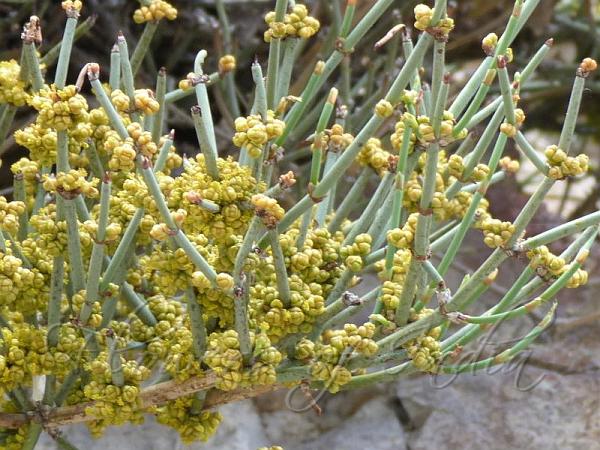|
| Somlata |
|

|

| File size | 635250 |
| Original date | 6/30/12 10:56 AM |
| Resolution | 2560 x 1920 |
| Flash | Flash did not fire, auto |
| Focal length | 4.1mm |
| Exposure time | 1/400s |
| Aperture | 4.0 |
| Focus Distance | |
| Metering Mode | Multi-segment |
| Camera make | Panasonic |
| Camera model | DMC-TZ10 |
| Sensor type | OneChipColorArea |
|
|
|
|
Photo: |
Botanical name: Ephedra gerardiana Family: Ephedraceae (Joint-Pine family)
Somlata is a low-growing rigid tufted shrub 1-2 ft
tall, with numerous densely clustered erect slender, smooth, green,
jointed branches, arising from a branched woody base. Branches have
scales at the joints. Male cones are ovate, 6-8 mm, solitary or 2-3,
with 4-8 flowers each with 5-8 anthers with fused filaments, and
rounded fused bracts. Female cones are usually solitary. Fruit is ovoid
7-10 mm, with fleshy red succulent bracts enclosing the seeds. Goats
and yaks feed on the branches during winter. Gerard Jointfir is found
on stony slopes, gravel terraces and drier places in the Himalayas,
from Afghanistan to Bhutan, at altitudes of 2400-5000 m. Flowering:
May-June.
Medicinal uses:  Ephedra gerardiana has very likely been used in India since the Vedic period as a
soma substitute. There came a time when the Aryans were no longer able
to find the original psychoactive plant known as soma, perhaps because
the identity of that plant was kept so secret or perhaps because it had
been lost, and so it was that many people took to preparing the sacred
soma beverage with substitute plants, one of which was E. gerardiana.
This is how the plant received the name somalata, ‘plant of the
moon’. The effects of E. gerardiana are more stimulating than
visionary, however, indicating that this plant is not the original soma
of the Vedas.
Ephedra gerardiana has very likely been used in India since the Vedic period as a
soma substitute. There came a time when the Aryans were no longer able
to find the original psychoactive plant known as soma, perhaps because
the identity of that plant was kept so secret or perhaps because it had
been lost, and so it was that many people took to preparing the sacred
soma beverage with substitute plants, one of which was E. gerardiana.
This is how the plant received the name somalata, ‘plant of the
moon’. The effects of E. gerardiana are more stimulating than
visionary, however, indicating that this plant is not the original soma
of the Vedas.
 Ephedra gerardiana has very likely been used in India since the Vedic period as a
soma substitute. There came a time when the Aryans were no longer able
to find the original psychoactive plant known as soma, perhaps because
the identity of that plant was kept so secret or perhaps because it had
been lost, and so it was that many people took to preparing the sacred
soma beverage with substitute plants, one of which was E. gerardiana.
This is how the plant received the name somalata, ‘plant of the
moon’. The effects of E. gerardiana are more stimulating than
visionary, however, indicating that this plant is not the original soma
of the Vedas.
Ephedra gerardiana has very likely been used in India since the Vedic period as a
soma substitute. There came a time when the Aryans were no longer able
to find the original psychoactive plant known as soma, perhaps because
the identity of that plant was kept so secret or perhaps because it had
been lost, and so it was that many people took to preparing the sacred
soma beverage with substitute plants, one of which was E. gerardiana.
This is how the plant received the name somalata, ‘plant of the
moon’. The effects of E. gerardiana are more stimulating than
visionary, however, indicating that this plant is not the original soma
of the Vedas. | Identification credit: Tabish | Photographed in Nubra Valley & Leh, Ladakh. |
• Is this flower misidentified? If yes,